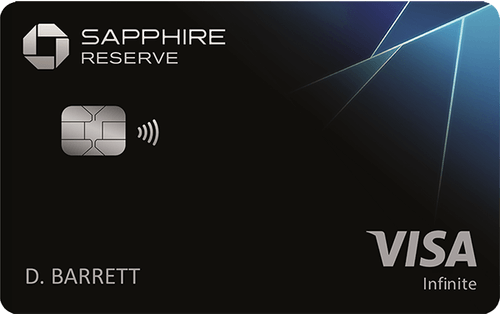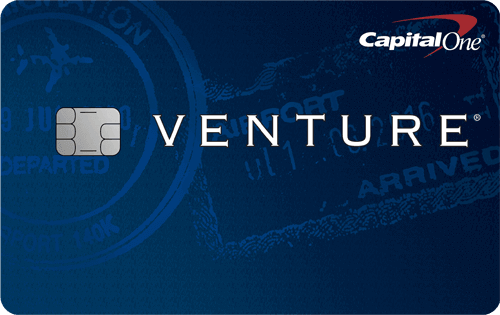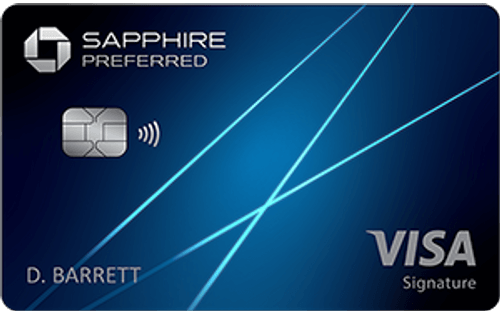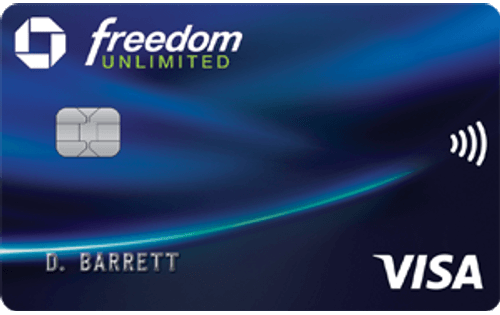Pros
- Initial Bonus: 60,000 points
- $300 Annual Travel Credit
- Up To 15% Back On Hotels and Car Rentals
Cons
- High Annual Fee
- High APR
Chase Sapphire Reserve®
- Earn 5x total points on flights and 10x total points on hotels and car rentals when you purchase travel through Chase Travel℠ immediately after the first $300 is spent on travel purchases annually. Earn 3x points on other travel and dining & 1 point per $1 spent on all other purchases
Earn 60,000 bonus points after you spend $4,000 on purchases in the first 3 months from account opening. That's $900 toward travel when you redeem through Chase Travel℠.
Rewards Details
- Earn 60,000 bonus points after you spend $4,000 on purchases in the first 3 months from account opening. That's $900 toward travel when you redeem through Chase Travel℠.
- $300 Annual Travel Credit as reimbursement for travel purchases charged to your card each account anniversary year.
- Earn 5x total points on flights and 10x total points on hotels and car rentals when you purchase travel through Chase Travel℠ immediately after the first $300 is spent on travel purchases annually. Earn 3x points on other travel and dining & 1 point per $1 spent on all other purchases
- Get 50% more value when you redeem your points for travel through Chase Travel℠. For example, 60,000 points are worth $900 toward travel.
- 1:1 point transfer to leading airline and hotel loyalty programs
- Access to 1,300+ airport lounges worldwide after an easy, one-time enrollment in Priority Pass™ Select and up to $100 application fee credit every four years for Global Entry, NEXUS, or TSA PreCheck®
Additional Info
- Count on Trip Cancellation/Interruption Insurance, Auto Rental Collision Damage Waiver, Lost Luggage Insurance and more
- Member FDIC
- More Details & Reviews About Chase Sapphire Reserve®
Is Chase Sapphire Reserve Worth It?
Chase Sapphire Reserve® is worth getting if you are a high-spending frequent traveler with excellent credit who spends a lot of time in airport lounges. With Chase Sapphire Reserve, the average person would earn over $1,800 in net rewards value over the first two years of use. That’s with the card’s annual fee factored in, too.
How Much Do You Have to Spend to Make Chase Sapphire Reserve Worth It?
If you spend at least $4,000 in the first 3 months after opening an account, Chase Sapphire Reserve will be worth it initially because that will earn you the card’s initial bonus of 60,000 points. The bonus alone will cover the $550 annual fee for nearly two years. Taking advantage of the $300 annual travel credit, complimentary access to a network of 1,300+ airport lounges and other valuable perks will also go a long way toward making the card worth owning.
Without the initial bonus factored in, you will have to spend around $2,000 to $55,000 per year for Chase Sapphire Reserve to be worth it, depending on what you purchase and how you redeem your points. When redeemed for cash back, Chase Sapphire Reserve points are worth a penny each, but the value jumps to 1.5 cents per point when you redeem for travel through Chase Travel℠.
Furthermore, as is the case with most rewards cards, you need to pay your bill in full every month, or else Chase Sapphire Reserve’s high APR will wind up eating away at your savings.
Chase Sapphire Reserve Review Highlights
-
60,000 Bonus Points
If you normally spend more than $1,334 per month and have a trip coming up in a few months, Reserve’s hefty bonus will save you a bundle. Charging at least $4,000 to the Reserve Card in the first 3 months after account opening will earn you 60,000 bonus points. That’s more than what the average card with an initial bonus gives you, according to WalletHub’s latest Credit Card Landscape Report. A lot of points don’t always translate into a lot of dollars, but Sapphire Reserve’s sure do. They’re worth $900 when redeemed for travel through Chase Travel and $600 as a statement credit.
-
Up To 15% Back On Hotels and Car Rentals
You will earn a total of 10 points per $1 spent on hotels and car rentals booked through Chase, a total of 10 points per $1 spent on prepaid restaurant reservations or takeout orders made through Chase, a total of 5 points per $1 spent on flights purchased through Chase, 3 points per $1 spent on all other travel and dining purchases, and 1 point per $1 on all other purchases. This translates to as much as 15% back when redeemed for travel through Chase Travel. So the more you spend in these bonus categories each month, the more likely Sapphire Reserve is for you.
For your convenience, here’s how Chase defines travel and dining:
TRAVEL Included Not Included Airlines Real estate agents Hotels/motels In-flight goods/services Discount travel sites Goods/services on a cruise Car rental agencies Sightseeing activities Cruise lines Tourist attractions Taxis Merchants in airports/hotels Buses Hauling-vehicle rental companies Passenger trains Purchased points Travel agencies Info Limousines Info Ferries Info Toll bridge/highway operators Info Parking lots/garages Info Timeshares Info Campgrounds Info DINING Included Possibly Not Included* Merchants whose primary business is sit-down/eat-in dining, including: Fast food restaurants
Fine dining establishmentsDining establishments within larger merchants, such as: Sports stadiums
Hotels
Grocery stores
Department stores
Casinos
Theme parks*Not included unless the merchant has classified the purchase as being dining-specific.
-
$300 Annual Travel Credit
You will automatically receive statement credits to cover the first $300 in travel purchases that you charge to the Sapphire Reserve Card each year. Credits will post to your account the same day qualifying purchases do and will appear on your monthly statement within 1-2 billing cycles.
It’s also worth noting that you can get the most out of this feature by applying toward the end of the calendar year. Your first $300 credit applies to purchases made between the date of account opening and the end of your first December billing period. So if you get this card in October, for example, you’ll have $300 in free travel to use by the end of the year (perhaps a bit sooner, depending on your billing cycle). And at that time, you’ll get a fresh $300 to use over the next 12 months. That would give you $600 in free travel in just 15 months instead of 24.
-
Complimentary Airport Lounge Access
Having the Sapphire Reserve Card enables you to sign up for a free membership with the airport-lounge operator Priority Pass Select. Membership would ordinarily cost at least $99 per year, but how valuable this perk actually proves to be depends on how often you frequent one of Priority Pass’s more than 1,300 lounges worldwide.
-
Rebate for Global Entry or TSA PreCheck
If you hate waiting in line for security at the airport, you’re going to like this. You can apply for TSA PreCheck at no cost, as Sapphire Reserve will refund the one-time $85 fee. Alternatively, if you’re an international traveler, Reserve will cover the $100 application fee for Global Entry, helping connect you to a smoother customs experience.
Chase Sapphire Reserve Review Lowlights
-
$550 Annual Fee
Very few credit cards charge higher annual fees than Chase Sapphire Reserve. In fact, Reserve’s $550 yearly charge is about 25 times higher than the average credit card’s annual fee.
-
Potential For A Very High APR
Granted, this card was not built for financing, but a $550 annual fee still should command a better rate than the average credit card for excellent credit (18.01% APR). That’s not the case, however. Reserve offers a regular APR that could be 22.49% to 29.49% (V), depending on creditworthiness.
Other Things To Consider About Chase Sapphire Reserve
-
Ability to Transfer Rewards Points
If you have multiple Chase credit cards, you can transfer your rewards points between them at no cost. You’ll want to transfer them to your Sapphire Reserve account, not from it, though. Sapphire Reserve points are worth more than most Chase Travel points.
-
Luxury Hotel & Resort Collection
As a Sapphire Reserve cardholder, you’ll have access to complimentary room upgrades, meals, discounts and other amenities at Chase’s hand-picked list of lodging establishments. Just make sure you don’t have to overpay on other aspects of your visit to offset these “free” perks.
-
Earning Maximum Value Limits Booking Options
Points are worth 50% more only when redeemed for travel booked through Chase Travel. This doesn’t necessarily limit the number of travel providers you’ll have to choose from, as Chase’s booking portal seems to have all the major airlines and hotel chains. But it does prevent you from shopping around to find the best price. You therefore need to consider how much that flexibility is worth to you.
-
Excellent Credit Required
You need excellent credit to even have a chance at qualifying for the Chase Sapphire Reserve Card. If you’re unsure whether your credit measures up, check your latest score for free on WalletHub.
Chase Sapphire Reserve vs. the Competition
The Chase Sapphire Reserve Card isn’t the only plane in the sky as far as travel rewards credit cards are concerned. So we crunched the numbers on how Reserve compares to its top competitors. You can check out our findings below.
*Earnings are based on the $28,523 in purchases that the average person can pay for with a credit card each year, according to data from the Bureau of Labor Statistics.
Chase Sapphire Reserve® Review Methodology
This Chase Sapphire Reserve® review is based on WalletHub’s proprietary 100-point credit card rating system. By using a consistent methodology to evaluate the Chase Sapphire Reserve® and all other cards, WalletHub’s credit card experts make it easy for people to compare their options and find the best credit cards for their needs.
The WalletHub rating system uses 16 key metrics grouped into seven categories: Fees, Rewards, Two-year Cost, Interest Rates, Approval Requirements, Special Features, and Reviews. Each metric has a maximum number of points allocated to it, based on the metric’s importance as determined by our editors. The points are added up to create an overall rating for the Chase Sapphire Reserve® out of a maximum of 100 points, which is then converted to a 5-point scale.
Ratings for each category reflect how close Chase Sapphire Reserve is to WalletHub’s definition of a 5-star credit card, which is based on market conditions and what we believe are reasonable terms. We compare Chase Sapphire Reserve to that standard to give a numerical approximation of how reasonable and competitive its terms are compared to other cards.
To learn more about how WalletHub rates credit card offers, check out our full credit card review methodology.








WalletHub experts are widely quoted. Contact our media team to schedule an interview.